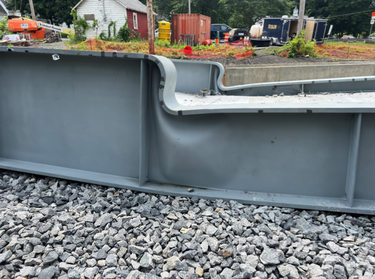‘Geometry issues’ during girder fabrication appear to have led to bridge collapse
“Severe web buckling,” says the caption under this picture in Colliers’ report, continuing, “top flange distortion and permanent girder deflection was noted on both through girders at the location of the girder depth transition.” The report from Colliers notes a “slight lateral shift in the through girders” in the caption for this picture and says the concrete deck placement had progressed to “approximately midspan.”
ALBANY COUNTY — The engineers hired by the county to try to figure out why the rail-trail bridge collapsed within weeks of being installed conclude “it does not appear that the particular construction means and methods were at the root cause of the collapse.”
Rather, the five-page report submitted by Colliers Engineering & Design states, “It appears that the shop inspection identified geometry issues during the fabrication of the girders. Additional stresses from beam fabrication (eventually approved by designer) could have contributed to the overall stresses that eventually led to the failure.”
The new pedestrian bridge over Route 85 in Slingerlands that buckled on July 12, and was removed in pieces on July 28, was meant to replace a century-old railroad bridge — part of the Albany County Helderberg-Hudson Rail Trail.
In 2019, the county had decided on a $1.9 million plan to remove the 42-foot wide existing railroad bridge and replace it with a two-girder structure that would be 14 feet wide, raising the structure to 15 feet, 6 inches above the roadway to meet state requirements.
The original bridge, built in 1912, had been in rough shape for some time. In 2019, the county said the bridge had been struck by vehicles passing beneath it nine times in the past 11 years. And it was struck several more times since.
Construction on the new bridge was to start in the summer of 2020 but was delayed by both the pandemic and litigation. The cost about doubled from the original $1.9 million because of legal challenges and having to relocate buried cable.
A 2008 report said that the bridge’s structural steel and much of its concrete were in “very poor condition.” And a 2017 inspection by the New York State Department of Transportation said that the structure was in such bad shape, its deficiencies could “significantly impact” the bridge’s “load carrying capacity.”
The railroad bridge was removed before the intended replacement bridge was installed in late June of this year, but the new, pedestrian bridge collapsed as concrete decking was being poured; no one was hurt.
The county announced on Thursday, Sept. 7, that Route 85 would reopen to traffic in both directions on Friday afternoon.
“With the drainage issues fixed, the new sidewalk installed, and paving now complete, construction work on State Route 85 in Slingerlands is coming to a close,” said a Thursday press release from the Albany County Executive’s Office. “While it is weather-dependent, final striping of the roadway is scheduled for tomorrow morning.”
Rail-trail walkers and cyclists are to continue to use a detour until an interim bridge is installed.
Construction on an interim steel truss bridge is to start on Oct. 2, the county said, and is scheduled to open on Oct. 31.
There will be a temporary lane closing on Route 85 once railing is delivered so it can be installed, the release said.
Engineers’ report
The Aug. 5 report from Colliers, obtained by The Enterprise through a Freedom of Information Law request, says Albany County requested the engineering company to perform three “investigative tasks”: visually inspect the bridge before it was demolished and removed; review available contract documents and construction phase submittals; and provide a preliminary engineering opinion as to the source of the bridge girder failure.
The visual inspection was conducted on July 25 and 27 by Brett Reynols, P.E. of Colliers, who also signed the report. Reynolds said the inspection “was limited to the steel bridge through girders, steel floor beams, concrete deck, bearings, and concrete abutments.”
The report includes photographs of “severe web buckling” over a length of about 52 inches.
Another photo, showing the length of the bridge, depicts a slight lateral shift in the through girders.
The report lists a series of plans, shop drawings, and site photographs from July 12 and 13 that Colliers reviewed as well as drone footage taken prior to the girder failure.
Colliers notes that the full set of bridge design computations was not available for review and states, “We reserve the right to modify these opinions upon further discovery.”
The report goes on to say that the bridge superstructure is “highly unique” with each girder featuring two locations where the top flange transitions from deeper to shallower web sections — this transition occurs instantaneously in a “step” configuration from horizontal to vertical.
“It is our understanding that this variable depth girder configuration was implemented to ‘mimic’ the original bridge which featured 3 separate spans with the middle span being deeper than the two flanking spans,” the report says.
“The failure of the bridge appears to have originated in the webs of the girders at the location of the top flange transitions,” the report continues. “The girder webs at this location appear to have buckled under the loading of the deck placement causing the girders to ‘hinge’ and collapse in on themselves at this location and then deflect downward until resting on the retaining walls below.”
The report says that typically these kinds of girder depth transitions are done gradually over a longer length with a “fish belly” configuration. With the rail-trail bridge configuration, it does not appear additional strengthening or web stiffeners were used.
“As the web and vertical stiffeners are consistent across the entire length of the girder, it does not appear that the design accounted for this additional stress concentration at the webs at the step location,” the report says.
